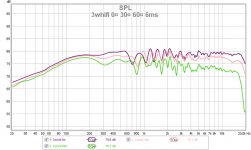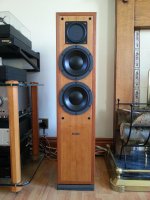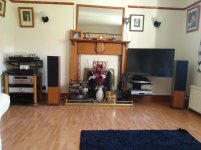It can't be dipole peak, it is most likely just diffractions from the rolled rubber surround and the baffle. Measurements are ugly but I'd like to hear this IRL. It would be interesting to measure the tweeter as a dipole too. Similar 3" tweeter appeared today in another thread here.
SoundStageNetwork.com | SoundStage.com | NRC Measurements: Cambridge Audio Aero 2
Xo i claimed to be 250Hz, which might be true as we see very high distortion around 200Hz!
SoundStageNetwork.com | SoundStage.com | NRC Measurements: Cambridge Audio Aero 2
Xo i claimed to be 250Hz, which might be true as we see very high distortion around 200Hz!
Last edited:
The reviewer replaced these(The best measuring speakers I've ever seen)
SoundStageNetwork.com | SoundStage.com | NRC Measurements: Magico S5 Loudspeakers with the Cambridge's and was still very, very impressed. Makes you wonder..
SoundStageNetwork.com | SoundStage.com | NRC Measurements: Magico S5 Loudspeakers with the Cambridge's and was still very, very impressed. Makes you wonder..
Homepage of the original BMR drivers CSS
Crossing these at 250Hz is crazy, around 4-500Hz would be much better. I hope that we will see more speakers using BMR drivers. I did not find any retail sellers yet.
I think that Parts Express still might be selling them from a manufacturer buy out. Unsure of quality, though.
I tuned out right after this:and was still very, very impressed. Makes you wonder..
"and the DH Labs cables lack the purity and clarity of the Siltechs and Crystals."
Well, I have been reading about speakers using BMRs. There are two sizes - 2½" and 4½" CA is using the small one and Rega R10 Rega Research Limited the bigger one as the mid in a 3-way.
Rega says that many people prefer a more clear and solid imaging, that's why they use a dome tweeter above 6kHz...
CA uses 2½" from 200Hz up and suffers from distortion there...
Summary - although being a really special invention and product, BMR does not give universal solution for hi-fi mid-high frequency reproduction. Compromises are needed.
This is the dispersion of my prototype 3-way, Avalon style narrow cabinet with 8" woofers, 4" mid and 3/4" tweeter. Low directivity, low distortion - interdriver vertical lobing problems do exist anyhow and perhaps coherence is not perfect... choose your way!
Rega says that many people prefer a more clear and solid imaging, that's why they use a dome tweeter above 6kHz...
CA uses 2½" from 200Hz up and suffers from distortion there...
Summary - although being a really special invention and product, BMR does not give universal solution for hi-fi mid-high frequency reproduction. Compromises are needed.
This is the dispersion of my prototype 3-way, Avalon style narrow cabinet with 8" woofers, 4" mid and 3/4" tweeter. Low directivity, low distortion - interdriver vertical lobing problems do exist anyhow and perhaps coherence is not perfect... choose your way!
Attachments
I tuned out right after this:
"and the DH Labs cables lack the purity and clarity of the Siltechs and Crystals."
Bummer, now I'll have to apply for a loan and buy the silky crystals cables.
This is where the "baby" and "bath water" thing comes into the equation..
I tuned out right after this:
"and the DH Labs cables lack the purity and clarity of the Siltechs and Crystals."
Correlation of measuremnts & subjective
Interesting to read the review and look at the measurements...
Ignoring the bass driver and passive crossover junk...
The baby BMR has low distortion, good power response with very linear listening window and an excellent on / off axis response within plus / minus 4dB over 150 degrees!
In addition the excellent Deviation from linearity is less than plus / minus 1dB between 90dB and 70dB.
All this from a $25 USD driver...Not to shabby!
A lot of this is due to the good Neo motor that CA OEM...The ferrite BMR's are very rough sounding.
I like the little C A aero speakers, within their limitations they offer good value and are easy to match with budget amps and sources.
Easy room placement too.
But...The tiny BMR surface area has serious SPL limitations, esp when covering everything above 200Hz...
An instant upgrade would be to ditch the passive crossover and use a Mini DSP or decent (£600 to £800 ish) AV amp with DSP.
I did this with a pair of Dynaudio floor standers and replaced the silk dome with a 4.5inch Neo BMR ( see attached) The customer is over the moon and I must admit I am amazed at just how great they sound in even with compromised room placement they fill a big room with very natural & powerful low distortion music.
Cheers
D.
Interesting to read the review and look at the measurements...
Ignoring the bass driver and passive crossover junk...
The baby BMR has low distortion, good power response with very linear listening window and an excellent on / off axis response within plus / minus 4dB over 150 degrees!
In addition the excellent Deviation from linearity is less than plus / minus 1dB between 90dB and 70dB.
All this from a $25 USD driver...Not to shabby!
A lot of this is due to the good Neo motor that CA OEM...The ferrite BMR's are very rough sounding.
I like the little C A aero speakers, within their limitations they offer good value and are easy to match with budget amps and sources.
Easy room placement too.
But...The tiny BMR surface area has serious SPL limitations, esp when covering everything above 200Hz...
An instant upgrade would be to ditch the passive crossover and use a Mini DSP or decent (£600 to £800 ish) AV amp with DSP.
I did this with a pair of Dynaudio floor standers and replaced the silk dome with a 4.5inch Neo BMR ( see attached) The customer is over the moon and I must admit I am amazed at just how great they sound in even with compromised room placement they fill a big room with very natural & powerful low distortion music.
Cheers
D.
Attachments
***Summary - although being a really special invention and product, BMR ***
***All this from a $25 USD driver...Not to shabby!
I don't see that this "BMR" part offers anything over another 2" ~25USD driver, the Aura Whisper. Seems to have about the same dispersion as a 2" cone/dome, but doesn't have that clean underhung motor.
Listening Vs reading spec sheets...
Maybe you should try listening!
Joking aside, if it was possible to judge a driver by graphs and specs there would only be a few drivers in production, the best measuring would be chosen every time....
The way drivers sound in real rooms is what counts, measurements are only a guide to narrow down the field.
By the way I do not like the sound of most BMR's, all the ferrite ones I have heard are average at best.
Most small BMR's simply have no dynamics and limited SPL capabilities.
If you get the chance to hear a good 4.5 inch Neo BMR based speaker I would be interested to hear your opinion of it.
Cheers
Derek.
"I don't see that this "BMR" part offers anything over another 2" ~25USD driver..."
Maybe you should try listening!
Joking aside, if it was possible to judge a driver by graphs and specs there would only be a few drivers in production, the best measuring would be chosen every time....
The way drivers sound in real rooms is what counts, measurements are only a guide to narrow down the field.
By the way I do not like the sound of most BMR's, all the ferrite ones I have heard are average at best.
Most small BMR's simply have no dynamics and limited SPL capabilities.
If you get the chance to hear a good 4.5 inch Neo BMR based speaker I would be interested to hear your opinion of it.
Cheers
Derek.
Yea...You've found the secret measurement
As long your a happy ra that's all that counts...
Everyone else can just retire and look at the listening window measurement...
Best not tell the reviewer cause he really likes them, and so do a lot of customers....Fools trusting their ears over a measurement.
Cheers
D.
As long your a happy ra that's all that counts...
Everyone else can just retire and look at the listening window measurement...
Best not tell the reviewer cause he really likes them, and so do a lot of customers....Fools trusting their ears over a measurement.
Cheers
D.
I think it seems like these drivers have huge potential for cleverly designed budget speakers. Not so sure about $550 bookshelf 2-ways at all (and yes, I realize that's not an expensive speaker by any stretch, but I'm thinking more like $150). If this speaker is what you're doing, wouldn't it make more sense to go a little bit smaller with the BMR and cross at 1k or so?
Maybe you should try listening!
People who make such comments generally peddle substandard products.
Joking aside, if it was possible to judge a driver by graphs and specs there would only be a few drivers in production, the best measuring would be chosen every time....
That's silly on basically every level.
Also, "best" how?
The way drivers sound in real rooms is what counts, measurements are only a guide to narrow down the field.
That's the kind of thing people with substandard products would claim, yes.
If you get the chance to hear a good 4.5 inch Neo BMR based speaker I would be interested to hear your opinion of it.
Do you have any axial and polar measurements that would give someone a reason to think the thing might have advantages over a good 4" driver, such as the Scan Disco 10F?
I think it seems like these drivers have huge potential for cleverly designed budget speakers.
Where? I ask because I honestly don't see what they offer over and above "conventional" drivers of like diameter. Dispersion is dictated by piston diameter (and the Cambridge measurements convincingly demonstrate that, and the Aura Whisper just plain looks like a better driver than this BMR), SPL is dictated by volume displacement, and so on. I just don't see a convincing advantage in either performance or price/performance. I'm genuinely curious what others seem to see in them outside of the buzzy name.
Pallas, it seems like BMR uses flexible flat membrane to "break laws". You seem to be stuck to "rigid pistonic model" physics. Old school large fullranges and BMR alike use flexible membrane - at low frequencies the whole membrane works like a piston but at higher Fq only the middle part vibrates. This virtually makes piston diameter smaller and gives wider dispersion. The animation at their website tries to show this.
Naturally, this feature is nonlinear in practice and leads to some problems that we can see in ragged highs and distortion - harmonic and most likely IMD. Large fullranges are peculiarity nowdays and I believe that BMR limits are also much lower and tighter than developers (previously working with NXT) and Overkill Audio think!
Naturally, this feature is nonlinear in practice and leads to some problems that we can see in ragged highs and distortion - harmonic and most likely IMD. Large fullranges are peculiarity nowdays and I believe that BMR limits are also much lower and tighter than developers (previously working with NXT) and Overkill Audio think!
- Status
- This old topic is closed. If you want to reopen this topic, contact a moderator using the "Report Post" button.
- Home
- Loudspeakers
- Multi-Way
- Balanced mode radiator speaker review. True anechoic measurements


